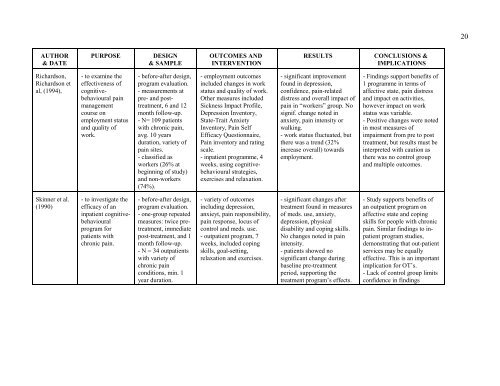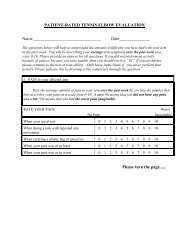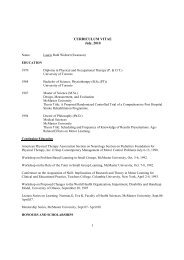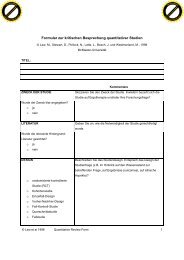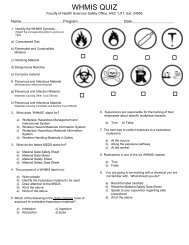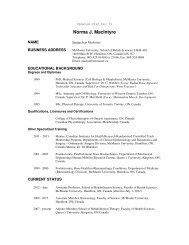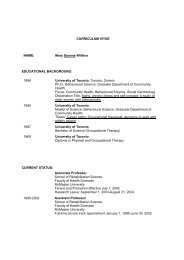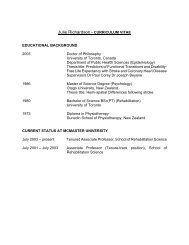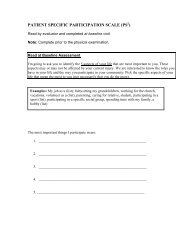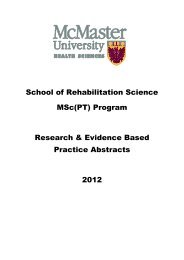The effectiveness of cognitive-behavioural interventions with people ...
The effectiveness of cognitive-behavioural interventions with people ...
The effectiveness of cognitive-behavioural interventions with people ...
You also want an ePaper? Increase the reach of your titles
YUMPU automatically turns print PDFs into web optimized ePapers that Google loves.
20AUTHOR& DATEPURPOSEDESIGN& SAMPLEOUTCOMES ANDINTERVENTIONRESULTSCONCLUSIONS &IMPLICATIONSRichardson,Richardson etal, (1994),- to examine the<strong>effectiveness</strong> <strong>of</strong><strong>cognitive</strong><strong>behavioural</strong>painmanagementcourse onemployment statusand quality <strong>of</strong>work.- before-after design,program evaluation.- measurements atpre- and posttreatment,6 and 12month follow-up.- N= 109 patients<strong>with</strong> chronic pain,avg. 10 yearsduration, variety <strong>of</strong>pain sites.- classified asworkers (26% atbeginning <strong>of</strong> study)and non-workers(74%).- employment outcomesincluded changes in workstatus and quality <strong>of</strong> work.Other measures includedSickness Impact Pr<strong>of</strong>ile,Depression Inventory,State-Trait AnxietyInventory, Pain SelfEfficacy Questionnaire,Pain inventory and ratingscale.- inpatient programme, 4weeks, using <strong>cognitive</strong><strong>behavioural</strong>strategies,exercises and relaxation.- significant improvementfound in depression,confidence, pain-relateddistress and overall impact <strong>of</strong>pain in “workers” group. Nosignif. change noted inanxiety, pain intensity orwalking.- work status fluctuated, butthere was a trend (32%increase overall) towardsemployment.- Findings support benefits <strong>of</strong>1 programme in terms <strong>of</strong>affective state, pain distressand impact on activities,however impact on workstatus was variable.- Positive changes were notedin most measures <strong>of</strong>impairment from pre to posttreatment, but results must beinterpreted <strong>with</strong> caution asthere was no control groupand multiple outcomes.Skinner et al.(1990)- to investigate theefficacy <strong>of</strong> aninpatient <strong>cognitive</strong><strong>behavioural</strong>program forpatients <strong>with</strong>chronic pain.- before-after design,program evaluation.- one-group repeatedmeasures: twice pretreatment,immediatepost-treatment, and 1month follow-up.- N = 34 outpatients<strong>with</strong> variety <strong>of</strong>chronic painconditions, min. 1year duration.- variety <strong>of</strong> outcomesincluding depression,anxieyt, pain responsibility,pain response, locus <strong>of</strong>control and meds. use.- outpatient program, 7weeks, included copingskills, goal-setting,relaxation and exercises.- significant changes aftertreatment found in measures<strong>of</strong> meds. use, anxiety,depression, physicaldisability and coping skills.No changes noted in painintensity.- patients showed nosignificant change duringbaseline pre-treatmentperiod, supporting thetreatment program’s effects.- Study supports benefits <strong>of</strong>an outpatient program onaffective state and copingskills for <strong>people</strong> <strong>with</strong> chronicpain. Similar findings to inpatientprogram studies,demonstrating that out-patientservices may be equallyeffective. This is an importantimplication for OT’s.- Lack <strong>of</strong> control group limitsconfidence in findings


